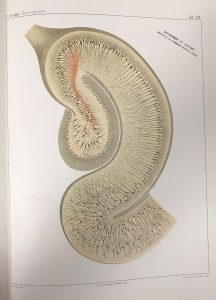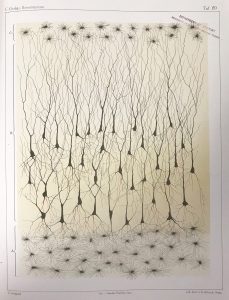
Camillo Golgi (1843-1926) was an Italian pathologist associated with the University of Pavia, where he studied and worked as professor of histology, chair of pathology, and dean and rector of the University. He is known for his work on the central nervous system, for which he was awarded the Nobel Prize in Physiology or Medicine in 1906, and which he shared with Santiago Ramón y Cajal.
While studying at the University of Pavia, under the influence of Cesare Lombroso, Golgi started his scientific career researching mental diseases, but quickly abandoned psychiatry in order to study the structure of the nervous system. Though tissue staining techniques in histological research were introduced in the mid-19th century, they were not sophisticated enough for investigating the nervous system. Golgi started his search for a better technique and ultimately discovered staining using potassium dichromate and silver nitrate (mentioned by him in 1873). This revolutionary technique of “black reaction,” later named after him (Golgi staining or Golgi impregnation), allowed for the first time a clear visualization and description of nerve cells. This discovery was a critical point in the development of modern neurology. Though Golgi himself could not see beyond the “reticular theory” (the belief that the nervous system consists of nervous fibers forming an intricate but continuous network), his work led to the establishment of neurons as a basic cell unit of the nervous system. He will be remembered as a man who pushed neurological research forward.

He was also the author of the first detailed description of “big nervous cells” and created the first drawing of the dog’s olfactory bulb (in 1875).
His bigger work, Sulla fina anatomia degli organi centrali del sistema nervoso, the monograph on investigations on the finer structure of the central and peripheral nervous system, was published ten years later. It included multiple illustrations revealing the mysteries of grey matter. Falk Library has this important work in a later German translation (Untersuchungen über den feineren Bau des centralen und peripherischen Nervensystems. Jena 1894). It can be viewed in the Rare Book Room by appointment.
~Gosia Fort